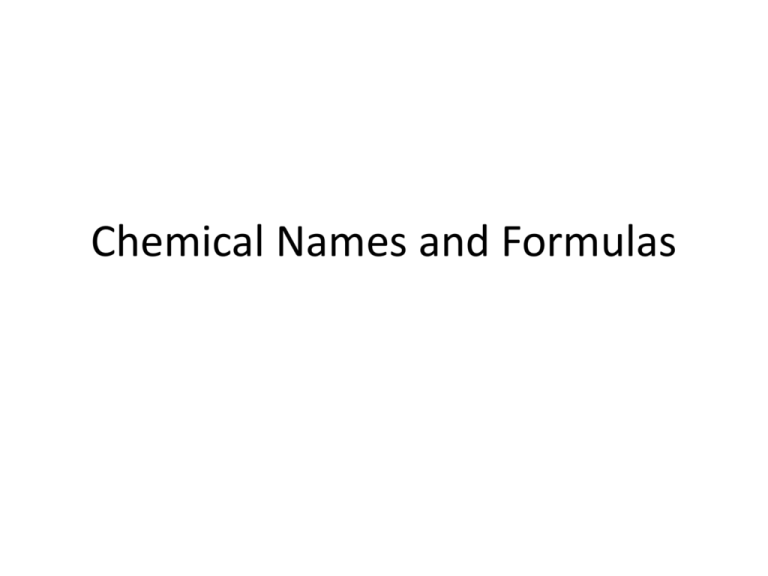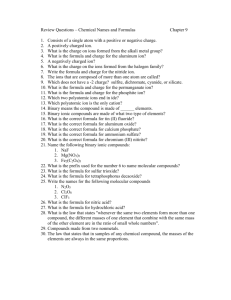Chemical Names and Formulas
advertisement

Chemical Names and Formulas Monatomic Ions Cations • Groups 1A, 2A, 3A charges = group number • Name: element name “ion” • Examples: • Na+ • Mg2+ • Al3+ sodium ion magnesium ion aluminum ion Common Cations Monatomic Ions Anions • Group A element charges = 8 - group number • Name: stem of element name + ide • Examples – Cl– S2– O2– N3- chloride sulfide oxide nitride Monatomic Ions Transition Metals (Group B) • Charges can’t be predicted from Periodic Table • Some are “multivalent” – Form more than one ion • Name: element name (charge) “ion” • “Stock” naming system – Use Roman numerals to indicate charge • • • • • Examples: Fe2+ Fe3+ Cu+ Cu 2+ Stock name iron (II) ion iron (III) ion copper (I) ion copper (II) ion Classical name ferrous ion ferric ion cuprous ion cupric ion Ionic Charges of Representative Elements Multivalent Cations Polyatomic Ions • Group of covalently bonded atoms that has a net charge • Most are anions • Oxyanions contain oxygen – End in –ate or –ite – SO42- sulfate – NO3- nitrate SO32- sulfite NO2- nitrite Common Anions Chloroxyanions • Polyatomic ions containing oxygen and chlorine Formula Name ClO- hypochlorite ClO2- chlorite ClO3- chlorate ClO4- perchlorate Polyatomic Ions • Some begin with hydrogen • H+ + CO32- → HCO3• H+ + PO43- → HPO42• H+ + HPO42- → H2PO4- hydrogen carbonate “bicarbonate” hydrogen phosphate “biphosphate” dihydrogen phosphate Polyatomic Cations • Ammonium Ion • H+ + :NH3 → NH4 + NH4 + 9.3 Naming and Writing Formulas for Molecular Compounds • Molecular compounds are named using a system of prefixes to indicate the number of each element in the compound • Do not use mono- before the first element • Example: SF6 sulfur hexafluoride • Example N2O4 dinitrogen tetroxide 9.4 Formulas and Names of Acids & Bases • Acids are compounds that have one or more ionizable hydrogens • General formula HnX • HCl (g) + H2O → H3O+ + Cl- (aq) Common Acids Names & Formulas for Bases • Bases are compounds which produce the hydroxide ion when dissolved in water • NaOH (s) → Na+ (aq) + OH- (aq) • NH3(g) + H2O → NH4+ (aq) + OH- (aq+ • Name as you would ionic compounds Law of Definite Proportions • aka Law of Constant Composition • For any compound, the percent composition by mass is always the same • A given compound always contains elements in exactly the same proportion by mass • E.g. percent composition of water by mass is 11.1% H and 88.9% O regardless of how much or how little there is • An ice cube and an iceberg have the same % composition. Law of Multiple Proportions • When two elements form different compounds, the mass of one element combining with the same mass of the other element occur in small whole number ratios H2O2 H2O Mass O 32 g 16 g Mass H 2g 2g Ratio O:H 16:1 8:1 Ratio O:O 16:8 = 2:1 Flow Chart to Name Chemical Compounds

